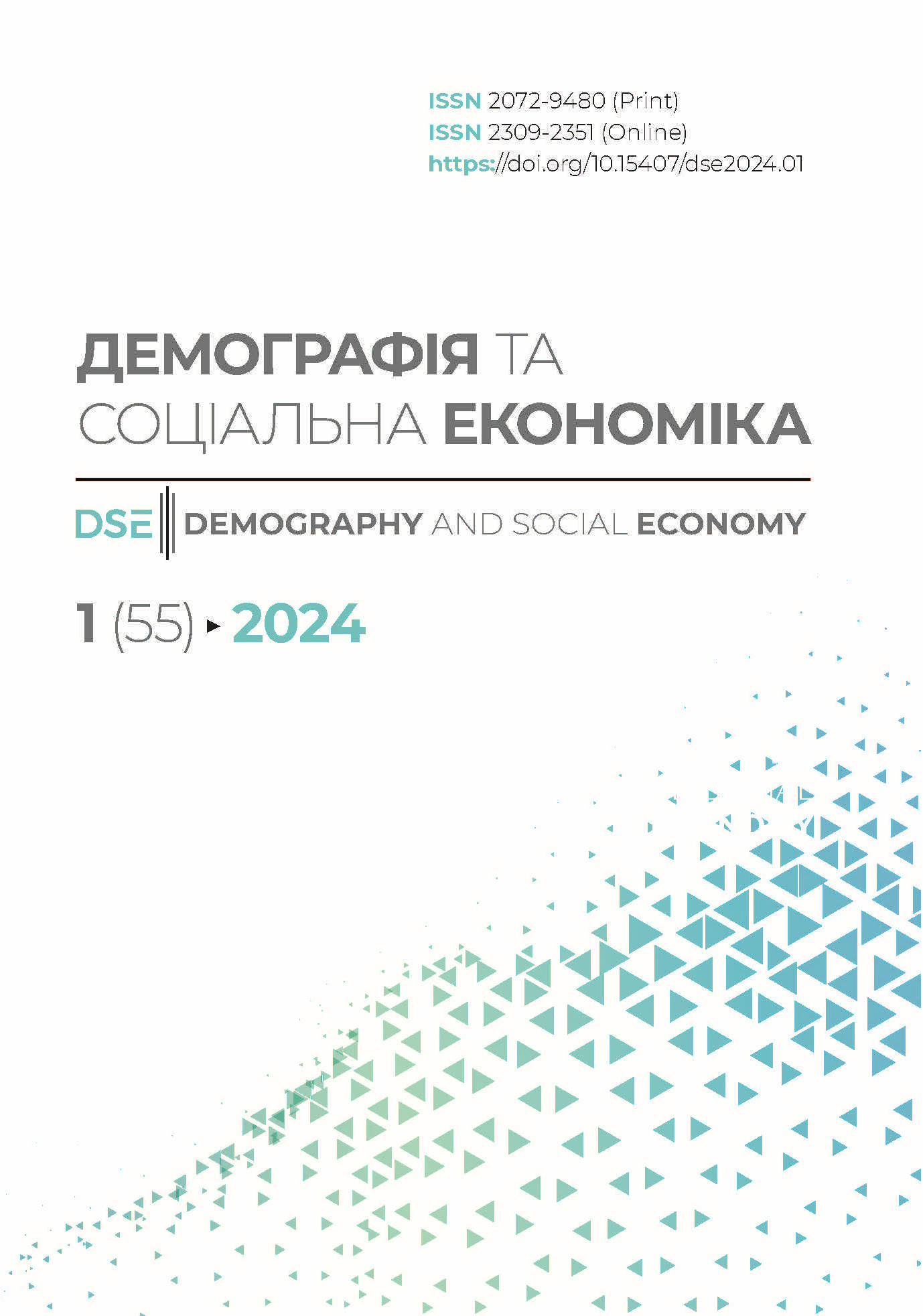PROBABLE CONSEQUENCES OF EUROPEAN INTEGRATION FOR THE DEVELOPMENT OF MIGRATION PROCESSES IN UKRAINE
DOI:
https://doi.org/10.15407/dse2024.01.094Keywords:
Ukraine, European integration, migrationAbstract
Population losses caused by the war, in particular forced migration abroad, are an obvious challenge to the stability of Ukraine, and can become a serious brake on its post-war recovery and development. Future EU membership carries with it the risk of further departure of citizens who will have the right to live, work, and study freely on the territory of a united Europe. In order to find adequate answers to possible problems in a timely manner, it is necessary to try to identify the most likely direction of the development of the migration situation in the context of European integration, which is the purpose of this article. Its novelty lies in the substantiation of the possible volumes of migration, its dynamics, composition and consequences under the influence of Ukraine’s accession to the European Union. The analysis is based on the most widely used theoretical approaches to explaining migration, data on intra-European migration movements after previous EU enlargements, as well as the migration experience of Ukrainians in recent decades. When processing factual and analytical material, historical, logical, comparative methods, the method of scientific abstraction are used.
Both theoretical considerations and actual data indicate a natural short-term intensification of migration of the population of the countries joining the EU. As a result of the war, the destruction of the economy, unemployment and impoverishment of the population, the exodus from Ukraine may be even larger. Additional ground for such an assumption is the experience of labor migration, which has been used by Ukrainians since the 1990s as a strategy for survival in crisis conditionst. At the same time, joining the EU, as it was proven by previous enlargements, contributes to the increase of labor productivity, the activation of the economy, the inflow of foreign investments and, as a result, the gradual increase of wages and the welfare of the population, which in the context of migration reduces the motivation to leave and determines the return. Citizens of Ukraine, as a democratic state, will independently decide whether to stay in the country, leave it or return to its territory. At the same time, the state can provide institutional and informational support to migrants, protect the interests of its citizens abroad, and create conditions for return. The development of migration policy taking into account the perspective of Ukraine’s accession to the EU is extremely relevant not only from a scientific, but also from a practical point of view.
REFERENCES
- Cabinet of Ministers of Ukraine (2022). Materials of the working group «Return of citizens temporarily displaced, in particular abroad, and their integration into the socioeconomic life of the state». https://www.kmu.gov.ua/storage/app/sites/1/recoveryrada/ua/return-of-temporarily-displaced-citizens.pdf [in Ukrainian].
- Ukrainian Information Agancy (2023). Ban men from leaving the country after the war. https://www.unian.ua/society/vijizd-cholovikiv-za-kordon-treba-zaboroniti-i-pislyaviyni-vadim-denisenko-12352503.html [in Ukrainian].
- Verkhovna Rada of Ukraine (2023). Speech of the President of Ukraine in the Verk hov na Rada of Ukraine on the Day of the Constitution of Ukraine. https://www.rada.gov.ua/ news/Top-novyna/238212.htm [in Ukrainian].
- Foundation “Democratic Initiatives” after Ilko Kucheriv. (2018). European integration in the dimension of public opinion. https://dif.org.ua/article/evropeyska-integratsiya-uvimiri-gromadskoi-dumki [in Ukrainian].
- UNHCR (2023). Lives on hold: Intentions and Perspectives of Refugees and IDPs from Ukraine. Regional Intensions Report #4. https://reliefweb.int/report/world/lives-hold-4intentions-and-perspectives-refugees-ukraine-regional-intentions-report-july-2023
- European Commission (2008). Employment in Europe. https://ec.europa.eu/social/ BlobServlet?docId=681&langId=en
- Dustmann, K., Casanova, M., Fertig, M., Preston, I., & Schmidt, C. (2003). The Impact on EU Enlargement on Migration Flows. Home Office Online Report — N 25/03. https:// ucl.ac.uk/~uctpb21/reports/HomeOffice25_03.pdf.
- Kahanec, M., & Zimmermann, K. F. (Eds.) (2010). EU Labor Markets After PostEnlargement migration. https://link.springer.com/book/10.1007/978-3-642-02242-5 https://doi.org/10.1007/978-3-642-02242-5
- Federal center of political education (2006). Expansion and the Free Movement of Workers: Do Continued Restrictions Make Sense for Germany. https://www.bpb.de/ themen/migration-integration/kurzdossiers/58165/the-results-two-years-afterenlargement-preliminary-results/
- Iakova, D. (2007). The Macroeconomic effects of Migration from the New European Union Members States to the United Kingdom. IMF Working Paper. https://www.imf. org/en/Publications/WP/Issues/2016/12/31/The-Macroeconomic-Effects-of-Migrationfrom-the-New https://doi.org/10.5089/9781451866254.001
- Verkhovna Rada of Ukraine (2022). Draft Law on the State Budget of Ukraine for 2023. Explanatory note. https://itd.rada.gov.ua/billInfo/Bills/Card/40472 [in Ukrainian].
- Mirror of the Week (2023). The permanent population of Ukraine is 29 million people. https://zn.ua/ukr/UKRAINE/-stanom-na-traven-2023-roku-postijne-naselennjaukrajini-stanovit-29-mln-osib-uim-.html [in Ukrainian].
- EWL Group (2023). War refugees from Ukraine. A year in Poland. A survey. https://ewl. com.pl/wp-content/uploads/2023/02/REPORT_REFUGEES_YEAR_IN_POLAND_ ENG_WWW-1.pdf
- Office for National Statistics (2023). Visa holders entering the UK under the Ukraine Humanitarian Schemes — Follow-up survey: 27 April to 15 May 2023. https://www.ons. gov.uk/peoplepopulationandcommunity/populationandmigration/internationalmigration/ bulletins/visaholdersenteringtheukundertheukrainehumanitarianschemes/27aprilto 15may2023
- Tucha, O., Spivak, I., Bondarenko, O., & Poharska, O. (2022). Impact of Ukrainian migrants on the economies of recipient countries. https://bank.gov.ua/admin_uploads/ article/Migration_impact_2022-12-15.pdf [in Ukrainian].
- Asscher, L. (2023). Integration of people fleeing Ukraine in the EU. Note to European Commission. https://ec.europa.eu/social/main.jsp?langId=en&catId=89&furtherNews=yes…
- Kahanec, М., Zaiceva, A., & Zimmermann, K. (2009). Lessons from Migration after EU Enlargement. IZA Discussion Paper No. 4230. https://docs.iza.org/dp4230.pdf https://doi.org/10.1007/978-3-642-02242-5_1
- Okólski, М., & Topińska, І. (2012). Social Impact of Emigration and Rural-Urban Migration in Central and Eastern Europe. Final Country Report. Poland https://ec.europa. eu/social/BlobServlet?docId=8839&langId=et
- European Integration Consortium (2009). Labour mobility within the EU in the context of enlargement and the functioning of the transitional arrangements. https://ec.europa. eu/social/BlobServlet?docId=2506&langId=en
- Kazsmarzsyk, P. (2006). Highly Skilled Migration from Poland and other CEE Countries: Myths and Realities. Center for International Relations. N 17/06. Reports & Analyses. http://pdc.ceu.hu/archive/00004820/01/rap_i_an_1706a.pdf
- Iglicka, K. (2006). Free Movement of Workers. Two years after the Enlargement: Myths and Reality. Center for International Relations. N 17/06. Reports & Analyses. http://pdc. ceu.hu/archive/00004813/01/rap_i_an_1106a.pdf
- Kahanec, М., & Zimmermann, K. (2009). Migration in an enlarged EU: A challenging solution? Economic Papers 363. https://ec.europa.eu/economy_finance/publications/ pages/publication14287_en.pdf https://doi.org/10.2139/ssrn.1329551
- Kupiszewski, M. (ed.) (2007). Demographic Developments, Labor Markets and International Migration in Poland — Policy Challenges. CEFMR Working Paper 3/2007. http:// cefmr.pan.pl/docs/cefmr_wp_2007-03.pdf
- Babakova, O. (2018). Socio-economic aspects of migrations in Poland (1989—2018). https://www.academia.edu/40858032/Socio_economic_aspects_of_migrations_in_ Poland_1989_2018_
Downloads
Published
How to Cite
Issue
Section
License
Copyright (c) 2024 Олена Малиновська

This work is licensed under a Creative Commons Attribution-NonCommercial-NoDerivatives 4.0 International License.


